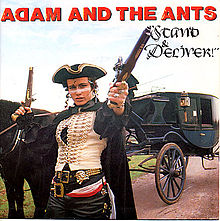
Adam and the Ants – Stand and Deliver Album Cover
Many years ago, “Stand and Deliver!” meant giving up your valuables or your life could be forfeit. Highwaymen were a common problem in England from around 1650 to 1800, where travel was already hazardous due to the lack of decent roads, no one rode alone without fear of being robbed. Often, people would group together or hire escorts to reduce the likelihood of attack and many travellers completed their wills before setting out on their journey.
Risk Management
This is an early example of risk management and some associated coping strategies. For instance, grouping together is an avoidance strategy based on the premise that the highwayman will not attack a larger group. Hiring escorts is a transfer strategy where the responsibility for action is transferred to the third party escort for a fee, writing a will could be construed as an acceptance strategy, by ensuring contingent measures for your family should you be unfortunate enough to not survive the ordeal and a mitigation strategy would be to adopt a completely different route.
In today’s world, “Stand and deliver!”, usually refers to a presentation, but let’s stay with the risk management concept for the moment.
As an experienced Project Manager, I have learned that good risk management is an important tool in the PM toolbox. Most PM methodologies now cite extended processes for identifying positive and negative risks, for analysing risks and for placing them into an organised Risk Register. These methodologies also suggest and recommend techniques for planning risk responses and even suggest strategic categories for dealing with negative risk such as avoidance, transference, mitigation and acceptance, whilst for positive risk there exists acceptance, enhancement, sharing and exploiting.
So, we follow these process and arrive at a well-crafted Risk Register that provides thought out details of the project risks, their probability, their likely impact and of course the coping strategies. Which the various methodologies also suggest should be part of the Project Management team’s current folders and should be regularly re-visited and updated.
But, rather like those expensive strategy reports produced by the big consultancies, how often do we really refer back to them? Maybe someone should take that up as a dissertation subject.
Newsflash – Risks change!
Issues are more often than not a risk that has become an issue or they are a risk that wasn’t captured that came up and bit you. For the unexpected issues, one has to think on your feet and deal with it as best you can, but for the known risks, there is a documented coping strategy for dealing with the risk and these may be equally applicable to the issue.
In reality, one should aim to avoid the issue by managing the risk appropriately, but sometimes it can’t be helped. We all know a case where the main expert on the project falls ill or is picked up for another “more important” task and you are expected to “Carry on!”.
A good programme manager will insist that all PM’s under their influence have regular risk meetings where the risk register is reviewed and updated. This means a serious review of the top 20% of the risks, a review of the watch list (a watch list is a list of risks with low probability / impact ratings which are monitored in case their probability changes), and a brainstorming session to identify any new risks not previously identified which might be sneaking up on you.
One of the support functions of a PMO should be to provide historical risk registers, so you can build a risk register that has relevant historical risk built into it and you can also see in the lessons learned what worked and what didn’t work so well. Lessons learned are another great resource that should be lodged with your PMO.
Shared Responsibility
The other point to note is that Risk management and coping strategies are a shared responsibility. If you are a stakeholder and you are identified as a risk owner, then you are responsible for doing something about your allocated risks. If you have to “pull” the expert, provide some time for a reasonable handover or keep them in an advisory capacity to the project, so as to give the PM some room to manage the impact.
By using historically successful examples and by working together, collaboratively whilst taking responsibility for our actions, we can develop risk management strategies that are effective and that mean the possibility of the project being impacted are much reduced.
These days, my daughter tells me that, “Stand and Deliver simply means ….it’s your turn on the Karaoke machine!”
As a seasoned Project Management Coach, I can help your teams see the historical benefits of good risk management and develop and embed modern proven techniques into your methodology. Should you need advice or assistance in dealing with risk management – contact me!
Now, Stand and Deliver by Adam and the Ants ……..where’s that microphone?
